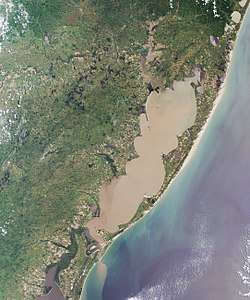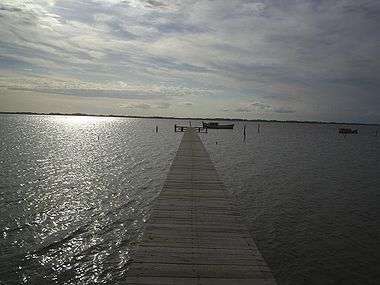Lagoa dos Patos
Lagoa dos Patos (Portuguese pronunciation: [laˈɡo.ɐ dus ˈpatus], [lɐˈɡow.wɐ], locally [laˈɡo.ɐ dos ˈpatʊs]; English: Ducks' Lagoon) is the largest lagoon in Brazil and the largest barrier-lagoon in South America.[1] It is located in the state of Rio Grande do Sul, southern Brazil. It covers an area of 10,100 km2 (3,900 sq mi),[1] is 180 miles (290 km) long and has a maximum width of 44 miles (71 km).[2]
| Lagoa dos Patos | |
|---|---|
 Lagoa dos Patos from satellite | |
 Lagoa dos Patos | |
| Location | Brazil |
| Coordinates | 31°06′S 51°15′W |
| Type | lagoon |
| Primary inflows | Jacuí-Guaíba and Camaquã River |
| Primary outflows | São Gonçalo Channel |
| Max. length | 180 miles (290 km) |
| Max. width | 44 miles (71 km) |
| Surface area | 10,100 km2 (3,900 sq mi) |
Lagoa dos Patos is separated from the Atlantic Ocean by a sandbar about 5 miles (8.0 km) wide. The Jacuí-Guaíba and Camaquã Rivers empty into it, while the navigable São Gonçalo Channel, which enters Lagoa dos Patos near the town of Pelotas, connects Lagoa dos Patos to Lagoa Mirim to the south.[1] The Rio Grande, at the south end of Lagoa dos Patos, forms the outlet to the Atlantic.[1]
This lagoon is evidently the remains of an ancient depression in the coastline shut in by sand bars built up by the combined action of wind and current. The shallow lagoon is located at sea level and its waters are affected by the tides, but they are brackish only a short distance above the Rio Grande outlet.[1]
The lagoon's largest and most fertile island is the Ilha dos Marinheiros, which is located near the eastern shore. The island is geopolitically part of the municipality of Rio Grande.
The lagoon hosts a rich biodiversity, including fresh- and brackish water fish, and water birds such as black-necked swan, coscoroba swan and Chilean flamingo.[1] Top predators from ocean ecosystem, notably common bottlenose dolphins, can sometimes be seen at Lagoa dos Patos[3][4] and exceptionally southern right whales are found at the Rio Grande outlet.[5][6]
Towns and cities on coast

References
| Wikimedia Commons has media related to Lagoa dos Patos. |
- "Laguna dos Patos". Freshwater Ecoregions of the World. Archived from the original on 9 January 2017. Retrieved 8 January 2017.
- Britannica.com - Patos Lagoon
- http://botosdalagoa.com.br/
- http://g1.globo.com/rs/rio-grande-do-sul/nossa-terra/2013/noticia/2013/04/projeto-de-universidade-monitora-golfinhos-em-rio-grande-no-rs.html
- http://zh.clicrbs.com.br/rs/noticias/noticia/2014/09/baleias-se-perdem-e-param-na-lagoa-dos-patos-no-rio-grande-do-sul-4595920.html
- "Archived copy". Archived from the original on 2016-01-30. Retrieved 2016-01-23.CS1 maint: archived copy as title (link)